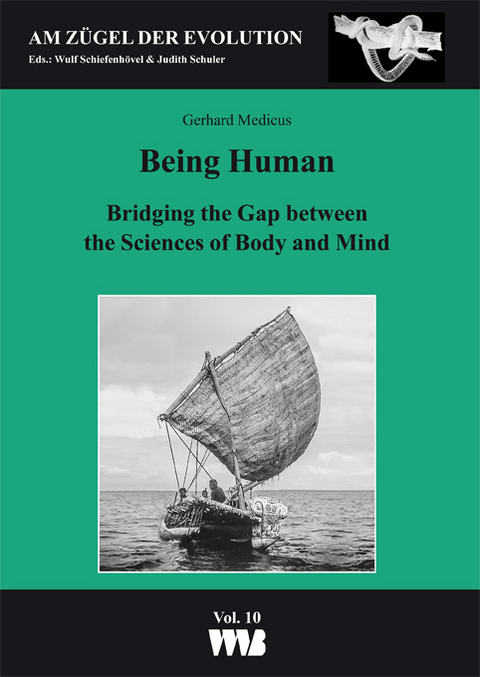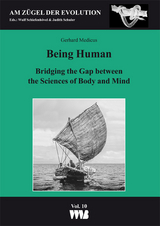Being Human
VWB-Verlag
978-3-86135-587-8 (ISBN)
- Keine Verlagsinformationen verfügbar
- Artikel merken
Evolution has left its traces on both the body and the soul. For this reason, accumulated evolutionary knowledge is a useful and indispensable underpinning for a better understanding of humans: social behaviour, moral consciousness, aggression and the inhibition of aggression, attachment behaviour, learning and intellect, political judgment and activity, as well as behavioural differences due to gender. The interlacing of nature, culture and mind is visible in all realms of humanness/human nature/humanity.
This knowledge can help to expand our behavioural freedom, and with that, our freedom to act responsibly.
List of Contents:
* Wulf Schiefenhövel: Foreword for the English Edition
* Preface
* Acknowledgements
*** PART I: Contributions to the epistemology of interdisciplinarity in the human sciences
* 1. Interdisciplinary theoretical foundation of the natural sciences
* 1.1 The central questions
* 1.1.1 The question of causation
* 1.1.2 The question of ontogeny
* 1.1.3 The question of adaptive value
* 1.1.4 The question of phylogeny
* 1.2 The reference levels
* 1.3 Chapter appendix: evolutionary psychology, evolutionary medicine
* 2. Contributions of the humanities to the interdisciplinary dialogue in human sciences
* 2.1 The body-mind problem: how it came to the separation of academic faculties
* 2.2 Approaches bridging the division between the humanities and the natural sciences
* 2.2.1 Popper’s postulate of falsifiability
* 2.2.2 The structure of the real world according to Nicolai Hartmann
* 2.2.3 Levels of evidence and demands for certainty
* 2.2.4 David Hume and Norbert Bischof
* 2.3 A plea in favour of orientational knowledge
* 2.4 Chapter appendix: forms of knowledge, Semmelweis Effect
*** PART II: Behavioural phylogeny in relation to the higher-level systematics of vertebrates
* 3. On the phylogeny of human cognition
* 3.1 Evolutionary stages of human cognition
* 3.1.1 Phylogenetic and ontogenetic knowledge gain
* 3.1.2 The evolution of cognitive capacities
* 3.1.3 Communal coexistence and culture; cultural-theoretical considerations
* 3.1.4 Overlaps between concepts of psychotherapy and ethology
* 3.2 Chapter appendix: further aspects of hominisation
* 4. From animal brood care to human social behaviour
* 4.1 From brood care to cooperativeness and its limits
* 4.2 Grieving, greeting and leave-taking
* 4.3 From brood care to sexual behaviour
* 4.3.1 Incest avoidance mechanisms
* 4.3.2 Gender differences
* 5. The apple from the tree of knowledge and the expulsion from paradise: on the evolution of morality
* 5.1 Questions about human nature
* 5.2 Evolutionary origins of humanity
* 5.2.1 Social attractiveness
* 5.2.2 Self-exploration and empathy
* 5.2.3 Time horizon and emphronesis as prerequisites for the ability to feel shame
* 5.2.4 Reflection and moral responsibility in adult humans
* 5.2.5 Summary: scope and limitations of cultural freedom
* 5.2.6 Concluding remarks
* 6. On the ethology of resource appropriation and ownership
* 6.1 The resource is appropriated by the strongest
* 6.2 The resource is appropriated by the higher-ranking individual and/or the first to arrive
* 6.3 Give and take
* 6.4 The right to possession is respected even in the absence of the owner
* 6.5 Chapter appendix: rank order and hierarchy
* 7. The natural difference: on the biopsychology of gender differences
* 7.1 General remarks and biological foundations
* 7.1.1 Benefits of sexual reproduction
* 7.1.2 Basic principles and causes for the origin of sexual dimorphism
* 7.2 Sexual reproduction in nonhuman and human primates
* 7.2.1 Excursus: communication in primates
* 7.2.2 The sociology of primate mating systems
* 7.2.3 The “principle of antithesis” in male-female differences
* 7.2.4 Human sexual behaviour
* 7.3 Variants of sexual behaviour
* 7.4 Prospects
* 8. Does the psychomotor development of children follow the biogenetic rule?
* 8.1 On the history of the biogenetic rule
* 8.2 Developmental physiological basis for recapitulation: metaphenes and interphenes
* 8.3 The significance of the biogenetic rule for biological research
* 8.4 The biogenetic rule and the ontogenetic development of behaviour
* 8.4.1 Interphenes commonly lack external adaptive value
* 8.4.2 Anatomical recapitulation with simultaneous functional “recapitulation"
* 8.4.3 The role of primordial behaviour in ontogeny
* 8.4.4 Morphogenesis and psychogenesis as distinct ontogenetic steps
* 8.4.5 No behavioural interphenes in nervous system ontogeny
* 8.5 Summary
*** PART III: Contributions to the ethology of specific behavioural areas and capacities, with an emphasis on universal traits in higher mammals and unique traits in apes and humans
* 9. On the evolutionary epistemological critique of constructivism
* 9.1 Information and “learning” genes
* 9.2 How do information, knowledge, (sense) organs and behaviour relate to the environment?
* 9.3 Convergence and consistency as evidences of truthlikeness
* 9.4 Expectation and experience
* 9.5 Constructions or reconstructions?
* 9.6 The three worlds according to Popper (1972)
* 9.7 Insights and methods of constructivism
* 9.7.1 Transparency
* 9.7.2 Pluralism versus monism
* 9.8 Conclusive remarks
* 10. Human infant attachment and its significance during life
* 10.1 Preliminary remarks
* 10.2 Ethological aspects of attachment
* 10.2.1 Human parents and their attachment to their children
* 10.2.2 Comparative cross-cultural observations on adult-child interaction
* 10.2.3 Allomothers and sibling-assisted brood care
* 10.2.4 Human children and their attachment to their parents
* 10.2.5 Programmed developmental stages of attachment and detachment
* 10.2.6 The Zurich model: the relationship between attachment, curiosity and independence
* 10.3 Incest inhibition
* 10.4 The susceptibility to attachment disorder
* 10.5 Concluding remarks
* 11. Aggression from a behavioural biological and cross-cultural perspective
* 11.1 Foundations
* 11.1.1 Misnamed forms of “aggression”
* 11.2 Conditions that lead to aggression
* 11.2.1 The three categories of genetic distance
* 11.2.2 Aggression across species and cultures
* 11.3 Conditions that help reduce or inhibit aggression
* 11.4 Summary
* 12. The biopsychology of the Zôon politikón
* 12.1 Foundations and preconditions for political behaviour
* 12.2 Constraints within small groups
* 12.3 Constraints within large societies
* 12.3.1 Affect-logic
* 12.4 Chapter-appendix: comparison of sociopolitical attitudes
*** List of the author’s publications used in this book
*** Bibliography
*** Subject Index
*** Author Index
| Erscheinungsdatum | 25.04.2017 |
|---|---|
| Reihe/Serie | Am Zügel der Evolution ; 10 |
| Übersetzer | Norbert Hohl, Sonia Kleindorfer |
| Verlagsort | Berlin |
| Sprache | englisch |
| Original-Titel | Was uns Menschen verbindet. Humanethologische Angebote zur Verständigung zwischen Leib- und Seelenwissenschaften |
| Maße | 170 x 240 mm |
| Gewicht | 600 g |
| Einbandart | gebunden |
| Themenwelt | Sozialwissenschaften |
| Schlagworte | Entwicklung • Evolution (Mensch) • Gesellschaft und Sozialwissenschaften • Humanethologie • Menschliche Evolution • Verhaltensforschung |
| ISBN-10 | 3-86135-587-6 / 3861355876 |
| ISBN-13 | 978-3-86135-587-8 / 9783861355878 |
| Zustand | Neuware |
| Haben Sie eine Frage zum Produkt? |
aus dem Bereich




